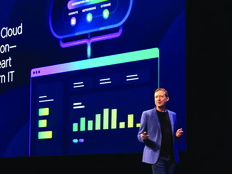The Navy CIO is focused on enabling programs to accelerate the delivery of new IT capabilities to warfighters at the tactical edge, improving their decision-making and survivability.
Cloud-managed Nautilus devices are replacing legacy systems aboard ships to allow for modern service delivery and secure information access from anywhere.
Nautilus devices are an extension of the Flank Speed ecosystem — unveiled in 2021 to push capabilities out to the Navy’s entire IT environment — that will see endpoints managed directly.
“Technical debt is eating our lunch every day,” said Deputy CIO Barry Tanner, speaking at WEST 2025 in San Diego on Tuesday. “So, modernizing and developing modern service delivery capabilities to move forward is still a huge priority within the armed forces.”
The Navy and Marine Corps plan to integrate the capability sets they’ve placed in their Microsoft 365 environments to improve their information sharing, which is driving the Department of Defense’s entire paradigm.
Click the banner below for answers to technologists’ nagging IT modernization questions.
Speed Is the Defining Characteristic of Modern Service Delivery
The Navy is in the process of putting prototypes on ships but has already held Microsoft Teams conversations successfully with the USS Abraham Lincoln in the middle of the Pacific Ocean last year.
“We’ve learned from these prototypes,” Tanner said. “And now we have to figure out how to scale.”
The development of manned and unmanned system capabilities must be linked to the seven joint warfighting functions: command and control, movement and maneuver, fires, intelligence, sustainment, protection and information, said Adm. Steve Koehler, commander of the Pacific Fleet.
Industry partnerships are crucial to integrating emerging capabilities such as artificial intelligence “as fast as humanly possible,” Koehler said.
“In our rapidly evolving battlespace, speed is the defining characteristic,” he said.
The Navy’s desire for information readiness is hastened by China’s public goal of being able to defeat the U.S. in a regional conflict by 2027, with their sights believed to be set on Taiwan.
“China continues to work to provide pressure to anybody in that region that will oppose them,” Koehler said. “And in this case, we all know that their designs on Taiwan and the unification thereof is within their plan and their desire.”
Chinese intimidation and shows of force around Taiwan continue to be monitored, and the Navy works to affect them daily, he said.
The Navy Isn’t Sleeping on Its Autonomous Systems Advantage
The rapid evolution of autonomous systems highlights the Navy’s need for adaptability, because the enemy is adapting, Koehler said.
The Navy is pursuing additional autonomous systems and the abilities to swarm and provide capabilities, even where the U.S. knows it has an initial advantage.
“It’s certainly what we’ve learned in Ukraine, as we’ve watched the Russians specifically adapt to the Ukrainian [unmanned arial systems] capability,” Koehler said.
To learn more about the annual West conference, visit our page. You can also follow us on the social platform X at @FedTechMagazine to see behind-the-scenes moments.














